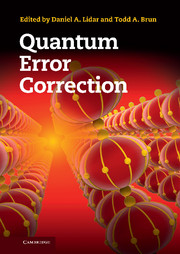Book contents
- Frontmatter
- Contents
- List of contributors
- Prologue
- Preface and guide to the reader
- Acknowledgements
- Part I Background
- Part II Generalized approaches to quantum error correction
- Part III Advanced quantum codes
- 9 Quantum convolutional codes
- 10 Nonadditive quantum codes
- 11 Iterative quantum coding systems
- 12 Algebraic quantum coding theory
- 13 Optimization-based quantum error correction
- Part IV Advanced dynamical decoupling
- Part V Alternative quantum computation approaches
- Part VI Topological methods
- Part VII Applications and implementations
- Part VIII Critical evaluation of fault tolerance
- References
- Index
11 - Iterative quantum coding systems
from Part III - Advanced quantum codes
Published online by Cambridge University Press: 05 September 2013
- Frontmatter
- Contents
- List of contributors
- Prologue
- Preface and guide to the reader
- Acknowledgements
- Part I Background
- Part II Generalized approaches to quantum error correction
- Part III Advanced quantum codes
- 9 Quantum convolutional codes
- 10 Nonadditive quantum codes
- 11 Iterative quantum coding systems
- 12 Algebraic quantum coding theory
- 13 Optimization-based quantum error correction
- Part IV Advanced dynamical decoupling
- Part V Alternative quantum computation approaches
- Part VI Topological methods
- Part VII Applications and implementations
- Part VIII Critical evaluation of fault tolerance
- References
- Index
Summary
Introduction
This chapter concerns quantum coding schemes based on iterative decoding. So far, most of the focus of this book has been on quantum error-correcting codes (QECCs) that use a relatively small number of qubits, and concatenation thereof. The decoding strategy adopted for these codes consists of identifying the lowest-weight error that is consistent with the syndrome and reversing its effect. The lowest-weight error associated with each syndrome can, in the worst case, be found by exhaustive search and stored in a look-up table for future reference. Each time a syndrome is measured, the appropriate recovery can be rapidly extracted from the table to complete the error-correction cycle.
In contrast, the codes described in this chapter use a very large number of qubits; the larger the better! For a fixed rate r = k/n, the performance of the codes improves as n increases. For such large codes however, more clever decoding schemes are required. For a code with parameters [[n, k, d]], the size of the look-up table – i.e. the number of distinct syndromes – is 2n−k = 2(1−r)n. Thus, look-up tables are only suitable for codes of a few dozen qubits. For larger codes, the decoding process involves a highly nontrivial computation that needs to be executed “on the fly,” so fast and reliable algorithms are needed. Iterative decoding is one such algorithm and it has produced some of the best coding schemes – in particular turbo-codes and sparse codes – widely used in classical wireless communication.
Information
- Type
- Chapter
- Information
- Quantum Error Correction , pp. 279 - 306Publisher: Cambridge University PressPrint publication year: 2013
